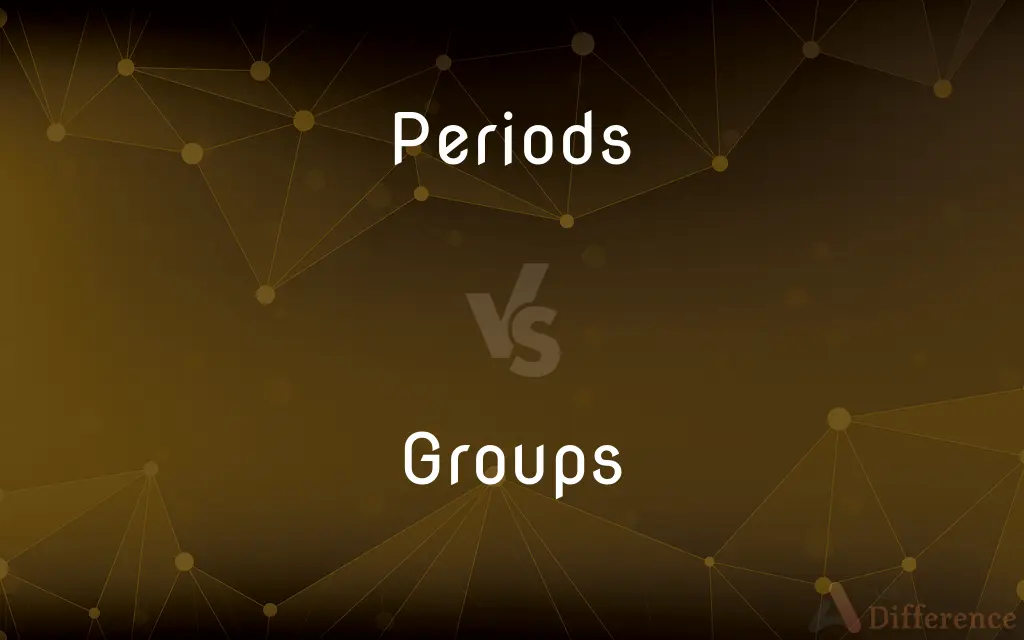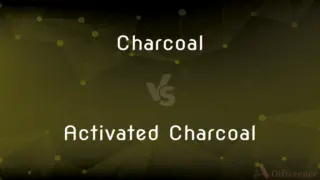Periods vs. Groups — What's the Difference?
Edited by Tayyaba Rehman — By Fiza Rafique — Published on July 8, 2024
Periods in the periodic table run horizontally and indicate the number of electron shells; Groups run vertically, representing elements with similar chemical properties and the same number of electrons in their outer shell.

Difference Between Periods and Groups
Table of Contents
ADVERTISEMENT
Key Differences
The periodic table organizes elements in a way that showcases the periodic trends and properties of elements, with periods and groups being two fundamental aspects of this arrangement.
Periods are the seven horizontal rows on the periodic table. Each period corresponds to a new electron shell being filled with electrons as you move from left to right across the table. The elements in a period start with a metal on the left, transition to metalloids in the middle, and end with non-metals on the right, reflecting a change in properties across a period. The number of the period indicates the number of electron shells an atom of an element in that period has.
Groups, also known as families, are the 18 vertical columns of the periodic table. Elements within the same group have similar chemical properties because they have the same number of electrons in their outermost shell, which determines how they react with other elements. For instance, all elements in Group 1, the alkali metals, are highly reactive in similar ways due to having one electron in their outer shell.
Groups are often more indicative of an element's properties than periods, as elements in the same group react similarly. For example, noble gases in Group 18 are all inert because their outer shell is full, making them unreactive. In contrast, the transition across a period from one element to the next can show a more gradual shift in properties, such as from metallic to non-metallic character.
Comparison Chart
Orientation
Horizontal rows
Vertical columns
ADVERTISEMENT
Number
7
18
Represents
Number of electron shells
Same number of electrons in outer shell
Chemical Properties
Vary across a period
Similar within a group
Reactivity
Changes from metals to non-metals
Generally consistent within a group
Example
Period 2 includes Li to Ne
Group 1 includes Li, Na, K, etc.
Compare with Definitions
Periods
Periods indicate electron shell count.
Oxygen in period 2 has 2 electron shells.
Groups
Groups contain elements with similar reactions.
Fluorine and Chlorine in Group 17 are both highly reactive non-metals.
Periods
(Chemistry) A sequence of elements arranged in order of increasing atomic number and forming one of the horizontal rows in the periodic table.
Groups
Same number of valence electrons.
All Group 2 elements have 2 electrons in their outermost shell.
Periods
Begins with metals, ends with non-metals.
Sodium starts period 3 as a metal, while Argon ends it as a non-metal.
Groups
Includes families like noble gases.
Helium, Neon, and Argon in Group 18 are inert gases.
Periods
Reflects a filling of electron shells.
Elements in period 4 fill the fourth electron shell.
Groups
Vertical columns on the periodic table.
The transition metals are found in groups 3 through 12.
Periods
Properties change across a period.
Carbon and Neon in period 2 show increasing non-metallic character.
Groups
Determines element's chemical properties.
Alkali metals in Group 1 are highly reactive due to one valence electron.
Periods
Length varies by electron shell capacity.
Period 1 has 2 elements, reflecting the first shell's capacity.
Groups
Two or more atoms behaving or regarded as behaving as a single chemical unit.
Periods
Physics & Astronomy The time interval between two successive occurrences of a recurrent event or phases of an event; a cycle
The period of a satellite's orbit.
Groups
A column in the periodic table of the elements.
Common Curiosities
How does the reactivity of elements change in a group?
Reactivity in a group can increase or decrease predictably, often related to how easily elements gain or lose electrons.
Can an element's period number change?
No, an element's period number is fixed, based on its electron shells.
What makes Group 18 elements unique?
Group 18 elements, noble gases, have full outer electron shells, making them exceptionally stable and unreactive.
Do elements in the same period have similar properties?
No, properties change across a period, showing a transition from metals to non-metals.
Are all elements in a period metals?
No, a period starts with metals and transitions to non-metals by the end.
Why are transition metals grouped together?
They have similar properties, including variable oxidation states and the ability to form colored compounds, and fill d orbitals progressively.
What determines the length of a period?
The length is determined by the number of orbitals being filled in that shell, reflecting the quantum mechanics underlying electron configurations.
How do alkali metals react with water?
Alkali metals react vigorously with water to produce hydrogen gas and alkali hydroxides, with reactivity increasing down the group.
Why are elements in the same group similar?
They have the same number of electrons in their outer shell, determining similar chemical behaviors.
What is the significance of valence electrons in groups?
Valence electrons determine an element's chemical properties and reactivity, explaining the similarity among elements in the same group.
Share Your Discovery

Previous Comparison
Lip Gloss vs. Lip Glass
Next Comparison
Probate Value vs. Market ValueAuthor Spotlight
Written by
Fiza RafiqueFiza Rafique is a skilled content writer at AskDifference.com, where she meticulously refines and enhances written pieces. Drawing from her vast editorial expertise, Fiza ensures clarity, accuracy, and precision in every article. Passionate about language, she continually seeks to elevate the quality of content for readers worldwide.
Edited by
Tayyaba RehmanTayyaba Rehman is a distinguished writer, currently serving as a primary contributor to askdifference.com. As a researcher in semantics and etymology, Tayyaba's passion for the complexity of languages and their distinctions has found a perfect home on the platform. Tayyaba delves into the intricacies of language, distinguishing between commonly confused words and phrases, thereby providing clarity for readers worldwide.











































